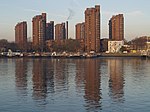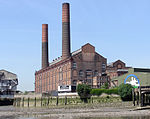Cremorne Gardens, London
1845 establishments in EnglandEntertainment in LondonFormer parks and open spaces of LondonGardens in LondonHistory of the Royal Borough of Kensington and Chelsea ... and 1 more
Pleasure gardens in England

Cremorne Gardens were popular pleasure gardens by the side of the River Thames in Chelsea, London. They lay between Chelsea Harbour and the end of the King's Road and flourished between 1845 and 1877; today only a vestige survives, on the river at the southern end of Cheyne Walk. Within the Chelsea area, Cremorne is a ward of the Royal Borough of Kensington and Chelsea. The 2011 census assessed the population of the ward at 7,974.
Excerpt from the Wikipedia article Cremorne Gardens, London (License: CC BY-SA 3.0, Authors, Images).Cremorne Gardens, London
Lots Road, London World's End (Royal Borough of Kensington and Chelsea)
Geographical coordinates (GPS) Address Nearby Places Show on map
Geographical coordinates (GPS)
| Latitude | Longitude |
|---|---|
| N 51.48 ° | E -0.17833333333333 ° |
Address
Cremorne Gates
Lots Road
SW10 0RS London, World's End (Royal Borough of Kensington and Chelsea)
England, United Kingdom
Open on Google Maps







